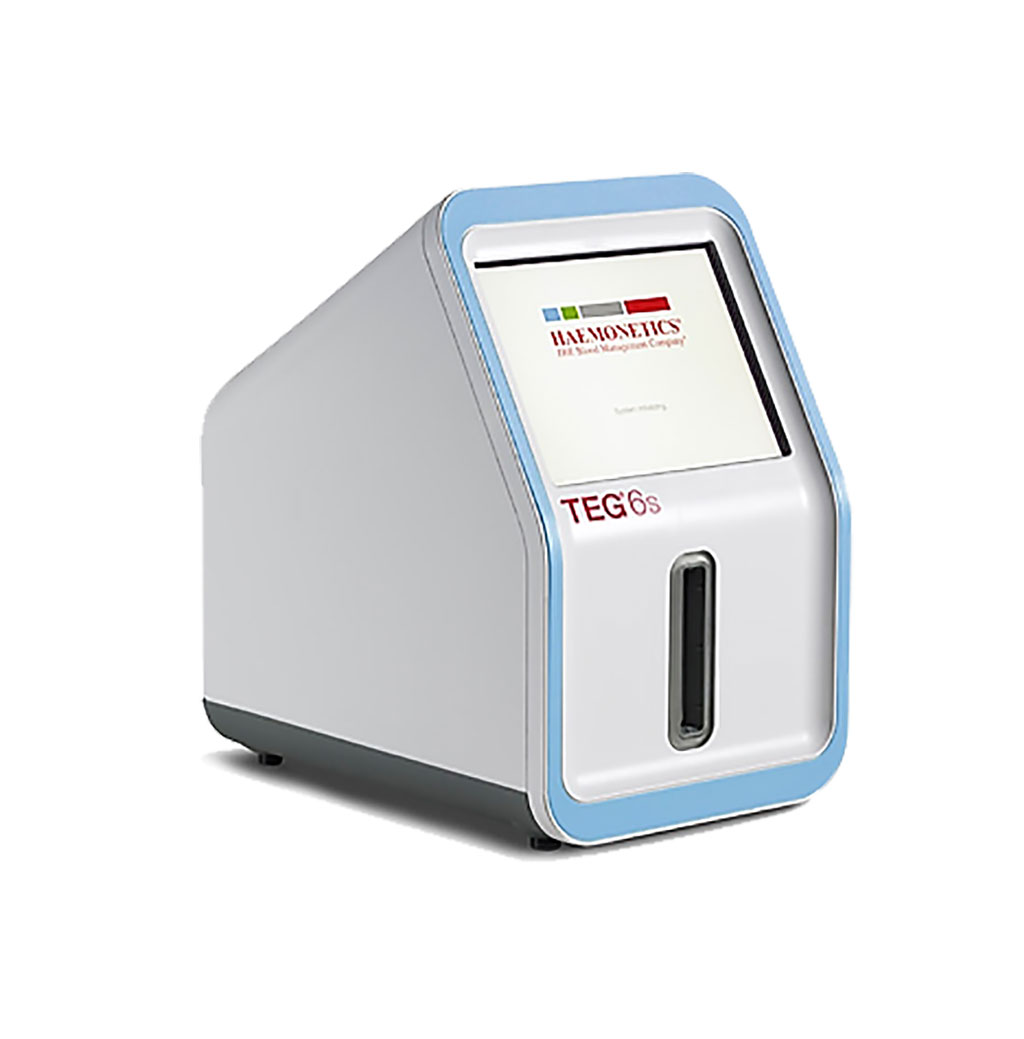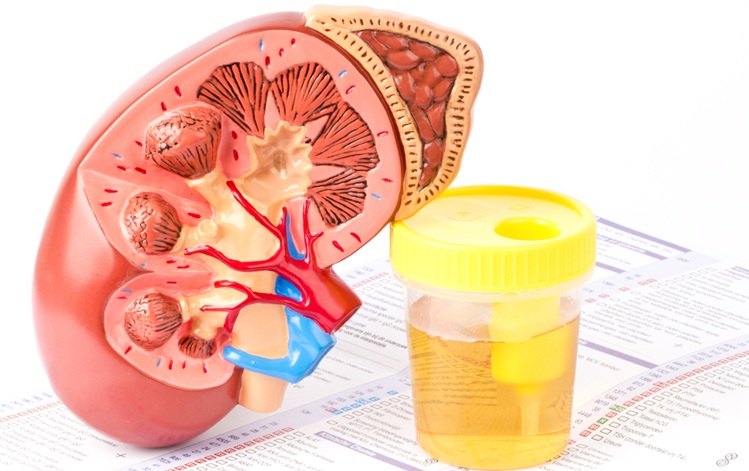Thromboelastography Identifies Undetected Blood Clots in COVID-19 Patients
|
By LabMedica International staff writers Posted on 15 Jun 2020 |

Image: Doctors recommend that all COVID-19 patients admitted to the ICU undergo a thromboelastography (TEG) to test for the risk of forming blood clots. The TEG 6s system provides rapid, comprehensive and accurate identification of an individual’s hemostasis condition in a laboratory or point-of-care setting (Photo courtesy of Haemonetics Corporation).
The coronavirus disease 2019 (COVID-19) pandemic has caused more than 400,000 deaths globally. Disseminated intravascular coagulopathy and other COVID-19–associated coagulopathies occur among patients with severe SARS-CoV-2 infections.
Thromboelastography (TEG) is a method of testing the efficiency of blood coagulation. It is a test mainly used in surgery and anesthesiology, although increasingly used in resuscitations in Emergency Departments, intensive care units, and labor and delivery suites.
Intensive Care Physicians at the Baylor St Luke’s Medical Center (Houston, TX, USA) and their associates observed 21 patients with COVID-19 infection from March 15 to April 9, 2020, confirmed with reverse transcription–polymerase chain reaction test of nasopharyngeal swab. All patients underwent TEG and TEG with heparinase correction on ICU admission. Hypercoagulability was defined as elevated fibrinogen activity greater than a 73° angle or maximum amplitude (MA) more than 65 mm on TEG with heparinase correction.
The doctors found that the standard clotting profile or screening of the patients was fairly normal. They were then moved to the next level of more specific clotting tests, which included analyzing a patient's fibrinogen and D dimer levels. Fibrinogen is the protein that makes up the clot and D dimer levels are used to indicate the rate at which a patient's clots are being broken down, which would usually suggest that the body is "chewing up" all of the clotting factors. For the COVID-19 patients in the ICU, the team found that the levels of fibrinogen were more than three times the normal range, indicating that the body was churning out this protein. Looking at these two results together, there was no clear indication that these patients were at increased risk for forming blood clots.
When the investigators used the thromboelastography test, they discovered the patients who they found were clotting their central intravenous and arterial lines and dialysis catheters had abnormally high clotting function compared to the patients who did not have clotting issues, and the clot breakdown function was significantly higher in the patients who were clotting less than others. Among the 21 patients studied, 13 of them, or 62%, developed 46 blood clots that could only be detected through the TEG test. For patients who are at a higher risk of blood clots as indicated by the TEG test, the team recommended administering additional blood thinners.
Todd K. Rosengart, MD, a cardiothoracic surgeon and senior author of the study, said, “The TEG test should be performed on all COVID-19 ICU patients immediately to find those who are at a higher risk of clotting. At the point where physicians discover that their central line and catheter is clotting, the horse is out of the barn.” The study was published on June 5, 2020 in the journal JAMA Network Open.
Related Links:
Baylor St Luke’s Medical Center
Thromboelastography (TEG) is a method of testing the efficiency of blood coagulation. It is a test mainly used in surgery and anesthesiology, although increasingly used in resuscitations in Emergency Departments, intensive care units, and labor and delivery suites.
Intensive Care Physicians at the Baylor St Luke’s Medical Center (Houston, TX, USA) and their associates observed 21 patients with COVID-19 infection from March 15 to April 9, 2020, confirmed with reverse transcription–polymerase chain reaction test of nasopharyngeal swab. All patients underwent TEG and TEG with heparinase correction on ICU admission. Hypercoagulability was defined as elevated fibrinogen activity greater than a 73° angle or maximum amplitude (MA) more than 65 mm on TEG with heparinase correction.
The doctors found that the standard clotting profile or screening of the patients was fairly normal. They were then moved to the next level of more specific clotting tests, which included analyzing a patient's fibrinogen and D dimer levels. Fibrinogen is the protein that makes up the clot and D dimer levels are used to indicate the rate at which a patient's clots are being broken down, which would usually suggest that the body is "chewing up" all of the clotting factors. For the COVID-19 patients in the ICU, the team found that the levels of fibrinogen were more than three times the normal range, indicating that the body was churning out this protein. Looking at these two results together, there was no clear indication that these patients were at increased risk for forming blood clots.
When the investigators used the thromboelastography test, they discovered the patients who they found were clotting their central intravenous and arterial lines and dialysis catheters had abnormally high clotting function compared to the patients who did not have clotting issues, and the clot breakdown function was significantly higher in the patients who were clotting less than others. Among the 21 patients studied, 13 of them, or 62%, developed 46 blood clots that could only be detected through the TEG test. For patients who are at a higher risk of blood clots as indicated by the TEG test, the team recommended administering additional blood thinners.
Todd K. Rosengart, MD, a cardiothoracic surgeon and senior author of the study, said, “The TEG test should be performed on all COVID-19 ICU patients immediately to find those who are at a higher risk of clotting. At the point where physicians discover that their central line and catheter is clotting, the horse is out of the barn.” The study was published on June 5, 2020 in the journal JAMA Network Open.
Related Links:
Baylor St Luke’s Medical Center
Latest Hematology News
- Viscoelastic Testing Could Improve Treatment of Maternal Hemorrhage
- Pioneering Model Measures Radiation Exposure in Blood for Precise Cancer Treatments
- Platelets Could Improve Early and Minimally Invasive Detection of Cancer
- Portable and Disposable Device Obtains Platelet-Rich Plasma Without Complex Equipment
- Disposable Cartridge-Based Test Delivers Rapid and Accurate CBC Results
- First Point-of-Care Heparin Monitoring Test Provides Results in Under 15 Minutes

- New Scoring System Predicts Risk of Developing Cancer from Common Blood Disorder
- Non-Invasive Prenatal Test for Fetal RhD Status Demonstrates 100% Accuracy
- WBC Count Could Predict Severity of COVID-19 Symptoms
- New Platelet Counting Technology to Help Labs Prevent Diagnosis Errors
- Streamlined Approach to Testing for Heparin-Induced Thrombocytopenia Improves Diagnostic Accuracy
- POC Hemostasis System Could Help Prevent Maternal Deaths
- New Test Assesses Oxygen Delivering Ability of Red Blood Cells by Measuring Their Shape
- Personalized CBC Testing Could Help Diagnose Early-Stage Diseases in Healthy Individuals
- Non-Invasive Test Solution Determines Fetal RhD Status from Maternal Plasma
- First-Of-Its-Kind Smartphone Technology Noninvasively Measures Blood Hemoglobin Levels at POC

Channels
Clinical Chemistry
view channel
VOCs Show Promise for Early Multi-Cancer Detection
Early cancer detection is critical to improving survival rates, but most current screening methods focus on individual cancer types and often involve invasive procedures. This makes it difficult to identify... Read more
Portable Raman Spectroscopy Offers Cost-Effective Kidney Disease Diagnosis at POC
Kidney disease is typically diagnosed through blood or urine tests, often when patients present with symptoms such as blood in urine, shortness of breath, or weight loss. While these tests are common,... Read moreMolecular Diagnostics
view channel
Urine Test Detects Early Stage Pancreatic Cancer
Pancreatic cancer remains among the hardest cancers to detect early. In the UK, around 10,000 people are diagnosed each year, but only 5% survive beyond five years. Late diagnosis is a major factor—more... Read more
Genomic Test Could Reduce Lymph Node Biopsy Surgery in Melanoma Patients
Accurately determining whether melanoma has spread to the lymph nodes is crucial for guiding treatment decisions, yet the standard procedure—sentinel lymph node biopsy—remains invasive, costly, and unnecessary... Read moreImmunology
view channel
Blood-Based Liquid Biopsy Model Analyzes Immunotherapy Effectiveness
Immunotherapy has revolutionized cancer care by harnessing the immune system to fight tumors, yet predicting who will benefit remains a major challenge. Many patients undergo costly and taxing treatment... Read more
Signature Genes Predict T-Cell Expansion in Cancer Immunotherapy
Modern cancer immunotherapies rely on the ability of CD8⁺ T cells to rapidly multiply within tumors, generating the immune force needed to eliminate cancer cells. However, the biological triggers behind... Read moreMicrobiology
view channel
Fast Noninvasive Bedside Test Uses Sugar Fingerprint to Detect Fungal Infections
Candida bloodstream infections are a growing global health threat, causing an estimated 6 million cases and 3.8 million deaths annually. Hospitals are particularly vulnerable, as weakened patients after... Read more
Rapid Sepsis Diagnostic Device to Enable Personalized Critical Care for ICU Patients
Sepsis is a life-threatening condition that occurs when the body’s response to infection spirals out of control, damaging organs and leading to critical illness. Patients often arrive at intensive care... Read morePathology
view channel
New Molecular Analysis Tool to Improve Disease Diagnosis
Accurately distinguishing between similar biomolecules such as proteins is vital for biomedical research and diagnostics, yet existing analytical tools often fail to detect subtle structural or compositional... Read more
Tears Offer Noninvasive Alternative for Diagnosing Neurodegenerative Diseases
Diagnosing and monitoring eye and neurodegenerative diseases often requires invasive procedures to access ocular fluids. Ocular fluids like aqueous humor and vitreous humor contain valuable molecular information... Read moreTechnology
view channel
Cell-Sorting Device Uses Electromagnetic Levitation to Precisely Direct Cell Movement
Sorting different cell types—such as cancerous versus healthy or live versus dead cells—is a critical task in biology and medicine. However, conventional methods often require labeling, chemical exposure,... Read more
Embedded GPU Platform Enables Rapid Blood Profiling for POC Diagnostics
Blood tests remain a cornerstone of medical diagnostics, but traditional imaging and analysis methods can be slow, costly, and reliant on dyes or contrast agents. Now, scientists have developed a real-time,... Read moreIndustry
view channel
Puritan Medical Products Showcasing Innovation at AMP2025 in Boston
Puritan Medical Products (Guilford, ME, USA), the world’s most trusted manufacturer of swabs and specimen collection devices, is set to exhibit at AMP2025 in Boston, Massachusetts, from November 11–15.... Read more
Advanced Instruments Merged Under Nova Biomedical Name
Advanced Instruments (Norwood, MA, USA) and Nova Biomedical (Waltham, MA, USA) are now officially doing business under a single, unified brand. This transformation is expected to deliver greater value... Read more










 (3) (1).png)











